The final installment from Jack Connors of the Chicago FD turret wagon history. Images in this article feature 6-7-3, Big John at various locations in the city; a display, a parade, and at two fire scenes.
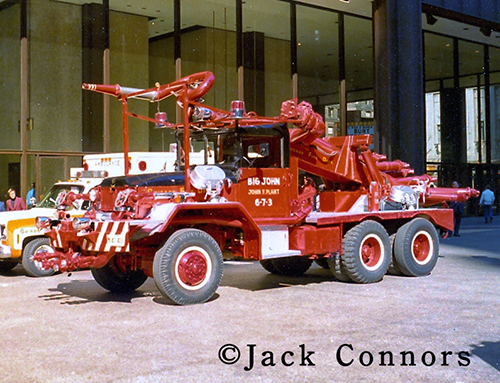
On display in October of 1974 in the Civic Centre Plaza for fire prevention week. Jack Connors photo
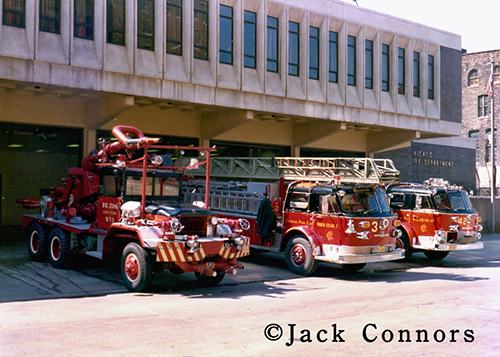
Big John at Engine 42’s house in April of 1974 with Engine 42 and Truck 3. Jack Connors photo
In this photo at Engine 42’s house on Illinois, Big John sits with engine 42 and Truck 3, both built by American LaFrance. This and only one other house in Chicago matched an American LaFrance engine and truck together. The other pair was Engine 112 with Truck 21.
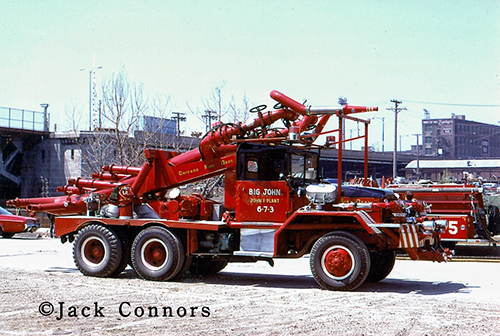
Standing by at a fire scene. Jack Connors photo
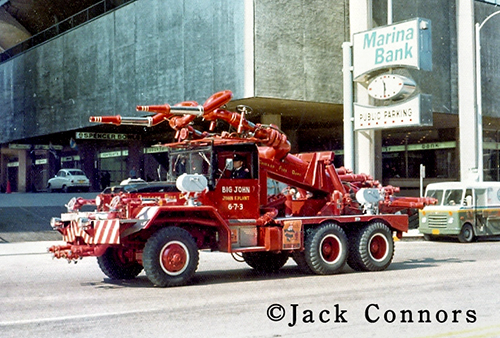
In the fire prevention parade, October of 1970. Jack Connors photo
On July 7, 1970, a 5-11 Alarm fire at 1750 N. Ashland Avenue resulted in the death of CFD Firefighter John Walsh when a wall fell onto a Snorkel. These next two images show Big John (6-7-3) deployed at that fire.
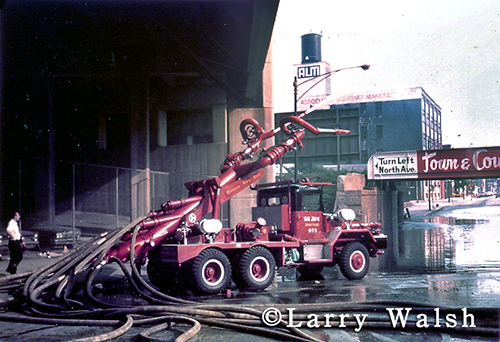
The fire was at 1750 N. Ashland Avenue, a 5-11 which caused the LODD of CFD FF John Walsh. Larry Walsh photo
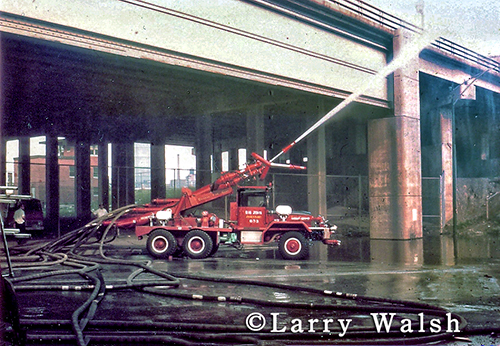
Big John deployed in July of 1970 at a 5-11 Alarm fire where CFD FF John Walsh was killed. Larry Walsh photo
From the Chicago Park District website:
Walsh Park occupies the former site of a vacant building destroyed in a spectacular and deadly fire on July 7, 1970. Firefighter John P. Walsh, Jr. (1923-1970), for whom this West Town park is named, died five weeks after being critically injured while fighting the stubborn blaze. Walsh had served as a United States Marine before joining the Chicago Fire Department in 1951. He had been assigned to Hook & Ladder Company 44. Several months after Walsh’s death, the Dana Civic Organization requested that the Chicago Park District develop the fire-scarred site as a neighborhood park. The park district had acquired the 2-acre property by the end of 1972, with the help of grant funds from the U.S. Department of Housing and Urban Development. Improvements began the following year. The 2-acre park includes playground equipment, an athletic field, basketball hoops, and a sand box.
From the Illinois Fire Service Institute:
 |
||||||||||||||||||||||||||
|
||||||||||||||||||||||||||
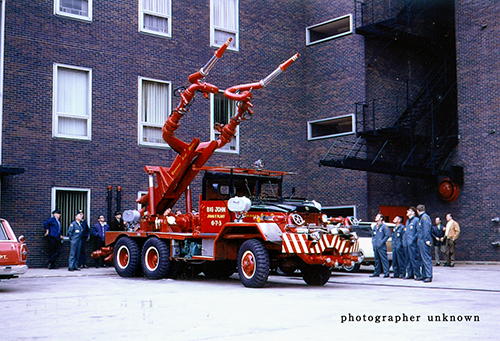
On display at the Chicago Fire Academy. photographer and date unknown
The beginning of this series can be found HERE.



















































#1 by David on November 13, 2015 - 2:13 PM
Bill, again, thanks a lot for the detailed info! The 10 year gap when the CFD didn’t purchase a single pumper is really interesting, on top of that in the age when the fire activity in Chicago was so much higher than today. I always thought that this may have been one of the reasons that they at about the same time (mid-late 1960’s) adopted the big deluge rigs concept – to counterweight the lack of new apparatus.
#2 by Bill Post on November 12, 2015 - 6:52 PM
David is this to correct a typo in my previous reply. Snorkel 4’s was Original 1960 Ford Hi/Ranger was given to Snorkel 3 after they had moved to Engine 60’s quarters in early 1970 as it had been a tight fit in Snorkel 3’s previous quarters with Engine 84 at 5721 S Halsted as it was a single bay station that had to fit both the Engine and the Snorkel in it. Before Snorkel 3 was given Snorkel 4’s old 80 foot Snorkel, Snorkel 3 had been using a 1959 model Ford Hi/Ranger 65 foot model. The IHC/Pierce Snorkel that was being used by Snorkel 4 since around 1967 was finally taken out of front line service around 1975 when Snorkel 4 received a new Oshkosh Pierce 75 foot Snorkel with a pump on it to kick up the water pressure on the Snorkel stream. After that the IHC/PIerce had become a Reserve Snorkel and it was marked as such.
#3 by Bill Post on November 12, 2015 - 1:46 PM
David Snorkel 4’s original Ford/High Ranger 80 foot model was not totaled when it was replaced by the IHC/Pierce about 5 years later.When the newer IHC Pierce was purchased and went in service around early 1967 the purchase was part of apparatus replacement program that had been approved by Chicago’s Voters during a bond issue campaign that was on the ballot around that time and the bond issue was campaigned for by not only the late Mayor Richard J Daley but by the late Fire Commissioner Robert J Quinn as Chicago had a tremendous need for new fire apparatus at the time especially for new Engine and Truck apparatus. Chicago had gone for 10 years without purchasing a new pumper apparatus (1956 to 1966) and even though Chicago had purchased 4 Mack/Magirus rear mounted Aerial Ladders in 1959/60 most of Chicago’s standard (tillered aerial apparatus) was much older and some of the older trailers had even dated back to the 1920″s and were pulled by newer Tractors that were by and large built in the 1940’s. Chicago did have newer tillered ladders that had been built in the late 40’s with the last ones delivered in 1956. From 1956 until 1966 the only new apparatus that Chicago had purchased were what would be called specialty or unique apparatus such at the Snorkels and the Fog Pressure (booster pumpers) and the Jet Boats (small fire rescue boats) and the ambulances and chiefs buggies of course. Chicago did have a desperate need for new Engines and Trucks though. The new Snorkel was included in that purchase however Snorkel 4’s 1960 Ford was handed down to Snorkel 3 when they were relocated from Engine 84’s old station at 5721 S Halsted to Engine 60’s current house on December 30th 1969. Before that the 1960 Snorkel was probably used as a spare rig and may have also been given to the Old Snorkel 2 to use however Snorkel 2 was taken out of service on 2/16/1969 from Engine 28’s current house. Snorkels 2 and 3 were using the 2 Original High Ranger Snorkels that were purchased in 1959. The reason why they did immediately give the 1960 Snorkel to Snorkel 3 until they were moved to Engine 60;s house is because Engine 84’s station was a very tight fit as it was a one bay station with the Engine and the Snorkel.
#4 by David on November 12, 2015 - 8:59 AM
Bill thanks a lot for the info! Also quite strange that Snkl 4 got a brand new rig (the IHC/Pierce) just some 5 years after the Ford/Strato tower. Was the Ford totalled in some accident? Thanks again!
#5 by Bill Post on November 11, 2015 - 9:01 PM
David the Snorkel that firefighter Walsh was in at the time of the building collapse was the Original Snorkel 7 that the CFD had run with. It was a 70 foot twin to the Original Snorkel 6 and was delivered in 1961 and the was one of 2 Strato Tower Snorkel booms. That same year (1961) two other twin Snorkels had been delivered earlier using 80 foot High Ranger booms which were assigned to Snorkels 4 and 5. Snorkel 5’s rig however had 2 turrets built into the Snorkel basket and was the only Snorkel in Chicago to have 2 turrets built into it.
After Snorkel 7 was totaled in the building collapse at 1722 N Ashland on July 7th 1970, the Snorkel was never replaced and at the time Snorkel 5 had become the only Snorkel that was located on the north side at the time (not including Snorkel Squad 1). Snorkel 7 had gone in service on January 11th 1962 at Engine 112 old station at 1732 W Byron. On June 9th 1966 Snorkel 7 was relocated the Engine 55’s current house on opening day and they were always assigned to the 3rd Division. When Chicago had run with the Original 7 Snorkels there was one assigned to each of the 7 Fire Divisions however it didn’t last that long as Snorkel 1 which was assigned to the old 2nd Division on the West Side was taken out of service on May 16th 1965 to become part of Snorkel Squad 3.
#6 by David on November 11, 2015 - 3:36 AM
Sad story, also I always wondered – was that Snorkel 4’s IHC/Pierce they were in when the wall hit them??? I know this was a relatively new rig at the time when this happened, but you won’t see the rig on later pics, so I guess it must have been this truck.
#7 by Frank on November 10, 2015 - 10:31 AM
I lived across the street from the house where John Walsh grew up. His mother, Peggy, still lived there and John would come to visit often. I was 11 when the fatal fire occurred and to this day can still vividly remember the procession up the 4700 block of Hermitage with John’s casket on top of an engine and what felt like thousands of firefighters walking lockstep in formation. They stopped in front of the Walsh house for an eternity. Everyone was crying. It may be one of the first experiences that caused me to go into public service.
Flash forward 30 years – our family buys a bar in Norridge and we’re renting the space. The landlord, a Chicago Firefighter, and I become friends. One day I relay the story of John’s funeral procession to him only to find out that he, Eddy Werderitch, was the firefighter John saved by covering him with his body in that bucket the day the wall fell. Small world.
#8 by Bill Post on May 10, 2013 - 12:01 PM
Yes, Brian if you scroll down the page about 10 entries, I mentioned that Engine 119 and Truck 55 were both using American LaFrances at the same time and so was Engine 1 and Truck 1 for a short while before Truck 1 was given the Morita Lift 135-foot. Truck 2 was given Truck 1’s American LaFrance as the Morita couldn’t fit into Truck 2’s old house. I believe that it was a dimension issue. Engine 64 and Truck 31 were also using ALFs at the same.
Of course the most recent ALF match was Engine 23 and Tower Ladder 5 until about 3 years ago.
#9 by BRIAN on May 10, 2013 - 3:14 AM
I PRETTY SURE ENG CO NO 119 AND H&L CO NO 55 WERE AMERICAN LAFRANCE AT THE SAME TIME TOO
#10 by Bill Post on May 2, 2013 - 11:51 AM
Yes you are correct NJ and there probably is more to it.
#11 by NJ on May 2, 2013 - 10:19 AM
Bill, as you can see even from the pics above, Big John could channel the water through one turret only even while equipped with both. I would think there must have been another reason for the mod.
#12 by NJ on May 2, 2013 - 10:17 AM
Does anyone know if CFD is planning to rechassis the piping and guns from 6-7-1? There was that new chassis spotted at the shops with a dual rear etc…..
#13 by Bill Post on May 2, 2013 - 4:11 AM
Rich I believe that Big John (673) was modified in order to concentrate the water trajectory into one large stream as opposed to having diluted it into two. If someone else knows of any additional technical reasons feel free to add to this. As far as I know the rig was gotten rid of years ago, but it would be a nice find if it is still around somewhere. I’m pretty sure that if it survived we would have known about it by now.
Big John was taken out of service due to hydraulic and mechanical problems. 671, which was originally numbered as 675, proved adequate for providing large master streams. Even though Big John looked impressive, it was built on an old 1952 surplus chassis from the army. All the CFD needs to do is remount the current 671’s piping and turrets onto a new chassis.
The New York City Fire Department (FDNY) has remounted similar turrets on their six Satellite Hose Wagons several times. The Satellite Hose Wagons are the remnants of the FDNY Super Pumper system of the 1960’s and 1970’s. They run the Satellite Hose Wagons as the second piece to a 2,000-gpm pumper, which run together on extra alarm fires. They are used to set up large water supply lines that are fed into the large turrets if necessary. During the last three years, FDNY has been upgrading all of their engine companies with 2,000-gpm pumps. Previously, only the six engines located with the Satellite Hose Wagons were of 2000 gpm capacity. The rest of their engines were officially rated at 1,000-gpm. Keep in mind that FDNY runs with 204 engines which includes seven squad companies. The squads are rescue/engines and function as an engine when they are first, second, or third-due. They also function as rescue and haz mat support companies.
#14 by Bill Post on May 1, 2013 - 5:05 PM
Chuck , Engine 107 and Truck 12 (who Truck 12 originally shared quarters with) both were using Ward La France rigs at the same time for a few years. They were not the same year models but Engine 107 had been using a 1967 , 1250 gpm model and Truck 12 was using a 1970 model Ward La France / Grove 100 foot Aerial Ladder truck. They were using both rigs together for about 8 years.
Engine 64 and Truck 31 were using American La France rigs together for a few years as well. The Cfd had American La France rehab a 1973 model Aerial Ladder Truck in 1991 and the rehabbed rig was assigned to Truck 31 when Engine 64 was using a 1978 model ALF 2000 gpm pumper.
#15 by Chuck on April 29, 2013 - 11:50 PM
Then begs the question, Jack…did anybody run paired WARD LaFrance rigs at all?
#16 by Rich on April 29, 2013 - 7:43 PM
why did they modified? Is it still alive today?[shop,stoarge or what?] That’s old rig should still be kept. Like the other turrent wagons they now here.Certain rigs should never be disband they should be updated! This would be priceless rig with the new fire boat they now have. Look at 671 REBORN!
#17 by Bill Post on April 29, 2013 - 7:10 PM
You’ll notice that Big John was modified later so it was running with only one large turret in it’s latter years.
#18 by Bill Post on April 29, 2013 - 7:05 PM
Engine 119 and Truck 55 also were running with ALFs together and Engine 1 and Truck 1 also were running with American LaFrances for a couple of years until Truck 1 received the Hendrickson/Pierce/Morita 135 foot elevator ladder.
#19 by Matt on April 29, 2013 - 12:20 PM
I think that E92 and T45 also had ALF Centuries at the same time as well